

|
|
|
|
I have an alter ego. Her name is EuroDonna. She looks a lot like me, but she wears classier clothes and owns more dresses than I do. She would die before buying a pair of white sneakers or wearing her husband's oversized, faded t-shirt to run to the grocery store. She never, ever leaves home without a scarf. EuroDonna dreams of living in Paris, in a flat that is upstairs from a cafe and bakery where she has her coffee and croissant every morning before she takes a walk down the bank of the Seine. She wanders around the city most days, carrying her notebook and a fountain pen filled with pink ink. She stops every few blocks to sit down and write. If it's raining, she goes into another cafe to fill her pages with ideas and her stomach with pastries, but if it's sunny she sits on a bench and writes as the tourist boats float by. Once in a while she slips into a bookstore to find something to read that is as decadent as the European chocolate she has just licked off her fingers. (Yes, of course she washes her hands before handling the books!) There's something eternally fresh about Paris and this je ne sais quoi When stripes came into vogue in the court of Louis XIV -- the Sun King -- in the 17th century, the patterning spread at least as far as Estonia where it was first emulated by the nobles who could afford to import clothes or have them custom made to their specifications. Later stripes filtered down to the national costume when the rich women tired of yesterday's fashions and gave their used garments to peasant women who eventually incorporated the design elements into their own hand-woven fabrics and home-made skirts. I think of the traditional hand-made clothing worn with few changes from generation to generation as 'garb' and modern styles that change from season to season as 'fashion'. Both ways of dressing make us slaves in one way or another. With garb, we simply wear what everyone else wears because there are no other options. With few changes over the generations, perhaps the introduction of stripes into a skirt or a new floral motif into the red embroidery on a white blouse, grandmother, mother, and daughter wear the same styles. With fashion, every generation has a unique look, and although we may feel like we have innumerable choices on the racks of discount and department stores, all of these choices conform to current market trends. When I was in school learning about the writings of Henry David Thoreau, I fell in love with the idea of non-conformity. I thought I was entirely unique, unlike any other person in the world, and I wanted that individuality to show through in everything I did and everything I wore. At the time, my mother sewed all of my clothes, so in a way I was a bit removed from the center of the fashion stage of the times, but even my hand-made one-of-a-kind slacks, skirts, blouses, and t-shirts were made with fashionable material and up-to-date patterns bought at the local fabric store. Although my mother was a top-notch seamstress, she wasn't a designer and neither was I. With knitting I find that I have the best of both worlds. I can take what I like from the newest styles and incorporate these elements -- just like Estonian peasant women did -- into the styles of clothing that best suit me as a quirky individual. I can use this year's Pantone color of the year, Radiant Orchid, and knit it into a 1950s-style Lopi yoke sweater or a Victorian lace shawl. I can copy a knitting stitch I see on a snug-fitting sweater at the department store and incorporated into an oversized tunic. I can copy the colorwork motif I see on a mitten and use it on a sock. I have a love/hate relationship with fashion. EuroDonna loves novelty and new ideas, the feel of different fabrics, the excitement of new colors and patterns every season. Plain-old American me hates feeling like a slave to the whim of designers -- whether from Paris, New York, London, or Shanghai -- who don't know me and often design clothing that would not look good on anyone besides a runway model. This poem reflects my feelings about fashion. EuroDonna hasn't read it yet.
|
|
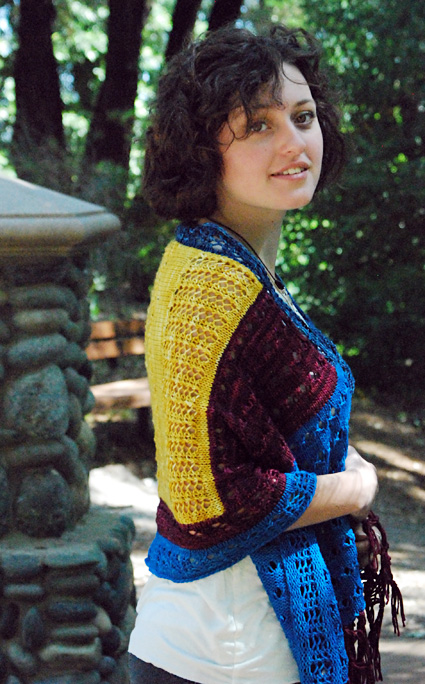
To me, this bright and simple, yet elegant, stole tells the story of brave women everywhere working to overcome stereotypes, limitations, and discrimination against those of us who were often referred to as “the weaker sex.” I see myself singing, dancing, speaking, and playing in the streets of Paris wearing this shawl as a celebration of being alive in a time and place where women have more freedom and choices than they have perhaps in any other time and place in history. |
|||
SIZE |
|
MATERIALS Notions |
| GAUGE |
18 sts/22 rows = 4 inches over St st |
PATTERN NOTES Instructions for the Long-Tail Cast On can be found here. Bind off: To keep the bound off edge loose, and to make it easier to pick up the stitches, BO using the larger needle in your right hand as you work the stitches. |
|
DIRECTIONS |
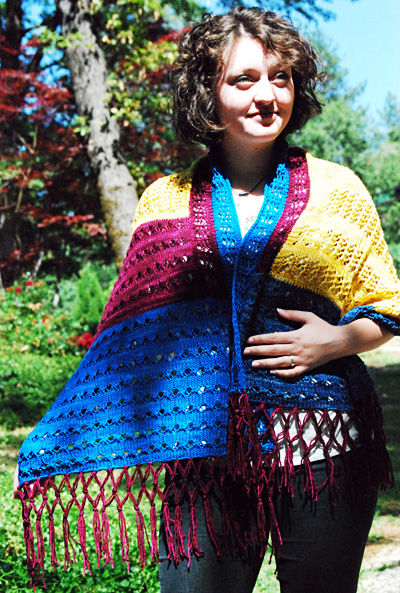 With She Sings and smaller needle, using the long-tail cast- on, loosely CO 60 sts. Work 3 rows in St st, starting and ending with a WS row.
She Dances Left Edge: 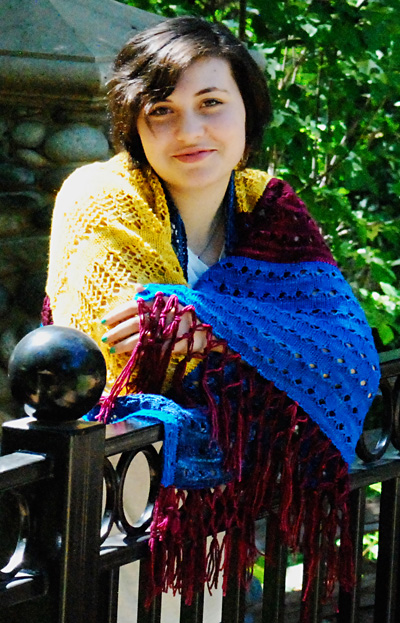 Bottom Edge: Change to She Speaks. With RS facing, pick up and knit 67 sts across short end of scarf -- 68 sts total. Work 3 rows in St st, starting and ending with a WS row. [Work 2 rows in Open Mesh. Work 6 rows in St st] 6 times. Using larger needle in right hand, BO. Return last st to working needle; do not cut yarn. Right Edge: She Plays Left Edge: 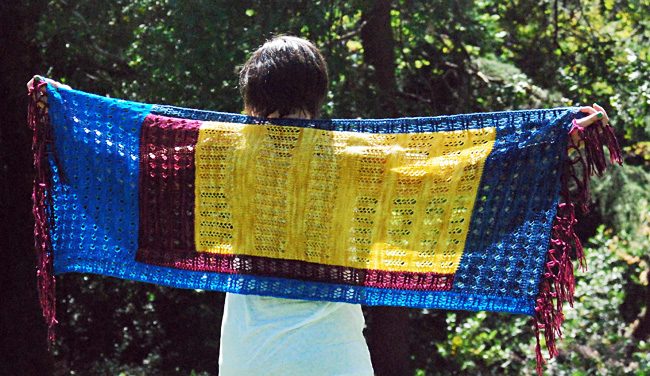 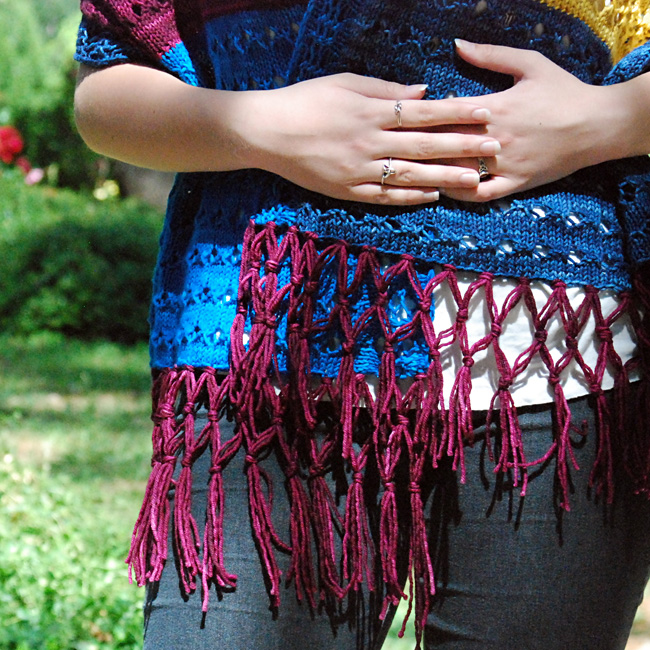
Weave in ends. Wash and block. With She Dances, add fringes to both short edge, if desired, as follows: Cut yarn of color of choice for fringe into 14-inch lengths. Hold 3 strands together, and fold them in half. Attach a strand of fringe every 1 inch across both short edges of the shawl as follows: Knot the fringes as follows: Trim the ends even, if desired. |
| ABOUT THE DESIGNER |
 Visit Donna's website at sheeptoshawl.com.
|
| Pattern & images © 2014 Donna Druchunas. All rights reserved. Contact Donna |